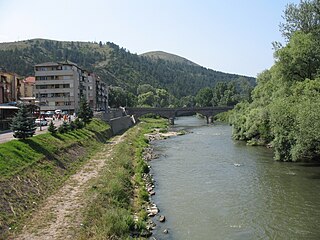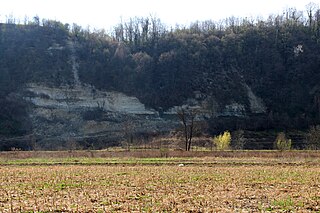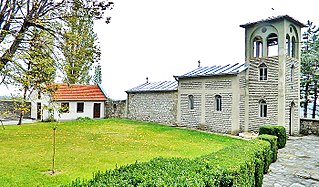
The Ibar, also known as the Ibër and Ibri, is a river that flows through eastern Montenegro, Serbia and Kosovo, with a total length of 272 km (169 mi). The river begins in the Hajla mountain, in Rožaje, eastern Montenegro, passes through Kosovo and flows into the West Morava river near Kraljevo, Central Serbia.
Mining in Japan is minimal because Japan does not possess many on-shore mineral resources. The Japanese mining industry began to rapidly decline in the 1980s. Coal production shrank from a peak of 55 million tons in 1960 to slightly more than 16 million tons in 1985, while coal imports grew to nearly 91 million tons in 1987. Domestic coal mining companies faced cheap coal imports and high production costs, which caused them chronic deficits in the 1980s. In the late 1980s, Japan's approximately 1 million tons of coal reserves were mostly hard coal used for coking. Most of the coal Japan consumed is used to produce electric power.

NMDC Limited, previously known as National Mineral Development Corporation, is an Indian state-controlled mineral producer. It is 72.43% owned by the Government of India, under the administrative control of the Ministry of Steel.

The Economy of Kosovo is a transition economy. Kosovo was the poorest province of the former Yugoslavia with a modern economy established only after a series of federal development subsidies in 1960s and 1970s. During the 1990s abolition of province's autonomous institutions followed by poor economic policies, international sanctions, little access to external trade and finance, and ethnic conflict severely damaged the already-weak economy. Since the declaration of independence in 2008 Kosovo's economy has grown each year, with relatively low effects from the global financial crisis; while there are many weaknesses for its potential in the future, many of them related to its internationally disputed status, there are also potential strengths, including its very low level of government debt and future liabilities and the strength of its banking system. Kosovo remains one of the poorest areas of Europe, with as much as 45% of the population living below the official poverty line, and 17% being extremely poor according to the World Bank.

Zijin Bor Copper d.o.o. Bor is a copper mining and smelting complex located in Bor, Serbia.
The Dushkaja mine is one of the largest nickel mines in Kosovo. The mine is located in Glogovac in Pristina district. The mine has reserves amounting to 6.35 million tonnes of ore grading 1.29% nickel, 0.05% copper, 24.29% iron, 44.09% silica and 9.33% magnesite thus resulting 82,000 tonnes of nickel, 3,175 tonnes of copper, 1,542,400 tonnes of iron, 2,800,000 tonnes of silica and 592,500 tonnes of magnesite.
The Suke mine is one of the largest nickel mines in Kosovo. The mine is located in Glogovac in Pristina district. The mine has reserves amounting to 0.63 million tonnes of ore grading 1.36% nickel, 0.06% copper, 30.56% iron, 49.17% silica and 9.48% magnesite thus resulting 8,600 tonnes of nickel, 378 tonnes of copper, 192,500 tonnes of iron, 309,800 tonnes of silica and 59,700 tonnes of magnesite.
The Gllavica mine is one of the largest nickel mines in Kosovo. The mine is located in Glogovac in Pristina district. The mine has reserves amounting to 6.24 million tonnes of ore grading 1.25% nickel, 0.05% copper, 21.53% iron, 50.89% silica and 13.52% magnesite thus resulting 96,700 tonnes of nickel, 3,120 tonnes of copper, 1,340,000 tonnes of iron, 3,180,000 tonnes of silica and 844,000 tonnes of magnesite.
The Goleš mine is one of the largest magnesite mines in Kosovo, located in Kosovo Polje, Pristina District. The mine has reserves of 1.74 million tonnes of ore, 46.23% magnesite and 2.66% silica, amounting to 804,400 tonnes of magnesite and 46,300 tonnes of silica.
The Strezovce mine is one of the largest magnesite mines in Kosovo. The mine is located in Kosovo Polje in Pristina district. The mine has reserves amounting to 3.66 million tonnes of ore grading 40.49% magnesite and 9.29% silica thus resulting 1,482,000 tonnes of magnesite and 340,000 tonnes of silica.

Šušeoka is a village situated in Mionica municipality in Serbia.
Mining in North Korea is important to the country's economy. North Korea is naturally abundant in metals such as magnesite, zinc, tungsten, and iron; with magnesite resources of 6 billion tonnes, particularly in the Hamgyeong-do and Jagang-do provinces. However, often these cannot be mined due to the acute shortage of electricity in the country, as well as the lack of proper tools to mine these materials and an antiquated industrial base. Coal, iron ore, limestone, and magnesite deposits are larger than other mineral commodities. Mining joint ventures with other countries include China, Canada, Egypt, and South Korea.
The Jadar mining project is a proposed mining site. The deposit is one of the largest lithium deposits in Serbia. The mine is located in western Serbia in Mačva District. The Jadar mine has reserves amounting to 125.3 million tonnes of lithium ore grading 1.8% lithium thus resulting 2.25 million tonnes of lithium. The deposit was discovered in the 2004 and in 2017 the Rio Tinto Group planned to start the mining operations in 2023.

The Winchester mine is a mining prospect and one of the largest magnesite deposits in Australia and the world. It is located in the Northern Territory, about three kilometres east of Batchelor. The deposit has estimated reserves of 16.6 million tonnes of ore with 91% magnesite.
The Xiafangshen Magnesium Mine is one of the largest magnesium mines in China and in the world. The mine is located in the central part of Liaoning Province, at the Xiafangshen Sedimentary Metamorphic Magnesite Deposit. The mine has estimated reserves of 258 million tonnes of ore 47.3% magnesium.

Cape Flattery is a cape in northern Queensland approximately 40 kilometres (25 mi) north of Cooktown, Queensland. The headland was named by James Cook on 10 August 1770 as he charted the eastern Australian coast.

Gorioč Monastery is Serbian Orthodox Monastery in Kosovo and Metohia region, metohion (dependency) of Visoki Dečani Monastery. By tradition it was founded in 14. c by Serbian King Stefan Dečanski, as a gift to St. Nicholas for the healing. Gorioč Monastery is situated on Bela Stena, near Istok. Around Monastery church dedicated to St. Nicholas, there are dormitories for nuns and guests as well as bell tower, small economic buildings and fishpond.










